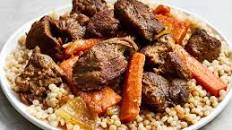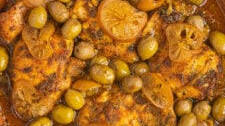Exploring Traditional Lamb Tagine Recipes
Lamb tagine is a beloved dish in Moroccan cuisine, known for its aromatic spices and tender meat that melts in your mouth. This traditional North African stew is slow-cooked in a conical clay pot, also called a tagine, which helps infuse the flavours and create a rich, hearty meal. Let’s delve into the world of traditional lamb tagine recipes and discover the art of creating this culinary masterpiece.
Ingredients:
- 500g lamb shoulder, cut into chunks
- 2 onions, finely chopped
- 3 garlic cloves, minced
- 2 tsp ground cumin
- 1 tsp ground ginger
- 1 tsp ground cinnamon
- 1 tsp paprika
- Salt and pepper to taste
- Handful of dried apricots
- Handful of pitted green olives
- Fresh coriander for garnish
Instructions:
- In a tagine or heavy-bottomed pot, heat some olive oil over medium heat.
Add the chopped onions and garlic, sauté until softened. Add the lamb chunks and brown on all sides. Sprinkle the cumin, ginger, cinnamon, paprika, salt and pepper over the lamb. lIi>Add enough water to cover the meat and bring to a simmer.
lIi>Cover with the tagine lid or foil and cook on low heat for about two hours until the meat is tender.
lIi>Add dried apricots and green olives to the tagine during the last half-hour of cooking.
lIi>Garnish with fresh coriander before serving.
Serving Suggestions:
Lamb tagine is traditionally served with fluffy couscous or crusty bread to soak up the delicious sauce. You can also accompany it with a side salad of fresh greens dressed with lemon juice and olive oil. A dollop of creamy yoghurt on top adds a cooling contrast to the warm spices of the dish.
This hearty dish is perfect for special occasions or cosy family dinners. The blend of sweet apricots, tangy olives, and fragrant spices creates a symphony of flavours that will transport you straight to Morocco with every bite. So why not try your hand at making this traditional lamb tagine recipe and savour a taste of North Africa at your own table?
Exploring Traditional Lamb Tagine: Key Ingredients, Cooking Methods, and Delicious Variations
- 1. What is a lamb tagine?
- 2. What are the key ingredients used in traditional lamb tagine recipes?
- 3. How do you cook lamb tagine in a tagine pot?
- 4. Can I substitute lamb with another type of meat in a tagine recipe?
- 5. Are there vegetarian or vegan versions of tagine recipes available?
- 6. What spices are commonly used in traditional lamb tagine dishes?
- 7. How long does it take to cook a lamb tagine properly?
- 8. What side dishes pair well with lamb tagine?
- 9. Are there any variations or twists to traditional lamb tagine recipes?
1. What is a lamb tagine?
A lamb tagine is a traditional North African dish that takes its name from the conical clay pot in which it is cooked. This slow-cooked stew features tender chunks of lamb, fragrant spices like cumin, ginger, and cinnamon, and a mix of sweet and savoury elements such as dried apricots and green olives. The unique shape of the tagine pot helps to infuse the ingredients with rich flavours while keeping the meat tender and succulent. Lamb tagine is a beloved culinary masterpiece that captures the essence of Moroccan cuisine, offering a delightful blend of textures and aromas that make it a favourite among food enthusiasts worldwide.
2. What are the key ingredients used in traditional lamb tagine recipes?
In traditional lamb tagine recipes, the key ingredients that lend this dish its distinctive flavours are a blend of aromatic spices and tender cuts of lamb. Commonly used spices include cumin, ginger, cinnamon, and paprika, which infuse the stew with a warm and fragrant essence. Onions and garlic provide a savoury base, while dried apricots add a touch of sweetness and pitted green olives contribute a tangy note. The combination of these ingredients creates a harmonious balance of flavours that make traditional lamb tagine a cherished culinary delight in Moroccan cuisine.
3. How do you cook lamb tagine in a tagine pot?
To cook lamb tagine in a tagine pot, start by heating some olive oil in the tagine over medium heat. Add finely chopped onions and minced garlic, sautéing until softened. Then, brown the lamb shoulder chunks on all sides before sprinkling them with ground cumin, ginger, cinnamon, paprika, salt, and pepper. Pour enough water to cover the meat and bring it to a simmer. Cover the tagine with its lid or foil and let it cook on low heat for about two hours until the lamb is tender. During the last half-hour of cooking, add dried apricots and pitted green olives for a burst of flavour. Garnish with fresh coriander before serving this aromatic and succulent dish that captures the essence of Moroccan cuisine.
4. Can I substitute lamb with another type of meat in a tagine recipe?
When it comes to traditional lamb tagine recipes, a common question that arises is whether one can substitute lamb with another type of meat. While lamb is the classic choice for a tagine due to its tender texture and rich flavour that pairs perfectly with the aromatic spices, you can certainly experiment with other meats. Beef, chicken, or even vegetarian options like chickpeas or root vegetables can be used as substitutes in a tagine recipe. Each variation will bring its own unique twist to the dish, allowing you to tailor the flavours to your preferences while still enjoying the essence of this iconic Moroccan stew.
5. Are there vegetarian or vegan versions of tagine recipes available?
For those seeking vegetarian or vegan alternatives to traditional lamb tagine recipes, there are indeed a variety of delicious options to explore. Vegetarian tagines often feature a medley of seasonal vegetables such as carrots, zucchini, bell peppers, and chickpeas, simmered in a fragrant blend of spices and herbs. Vegan versions may incorporate ingredients like tofu, tempeh, or plant-based protein sources to create a hearty and satisfying dish that captures the essence of Moroccan flavours. These plant-based adaptations offer a delightful twist on the classic tagine, providing a culinary experience that is both vibrant and nourishing.
6. What spices are commonly used in traditional lamb tagine dishes?
In traditional lamb tagine dishes, a harmonious blend of aromatic spices is key to creating the rich and complex flavours that define this North African delicacy. Commonly used spices include ground cumin, which adds a warm earthiness, ground ginger for a subtle heat, ground cinnamon for a sweet depth, and paprika for a hint of smokiness. These spices work together to elevate the tender lamb meat to new heights, infusing each bite with a symphony of tastes that evoke the essence of Moroccan cuisine.
7. How long does it take to cook a lamb tagine properly?
Cooking a lamb tagine properly is a patient art that rewards those who take the time to let the flavours meld together. Typically, it takes around two to two and a half hours to cook a lamb tagine properly. This slow cooking process allows the meat to become tender and infused with the aromatic spices, creating a dish that is rich in flavour and depth. The key is to simmer the tagine on low heat, ensuring that all the ingredients have enough time to blend harmoniously. So, while it may require some patience, the end result of a perfectly cooked lamb tagine is well worth the wait.
8. What side dishes pair well with lamb tagine?
When it comes to pairing side dishes with traditional lamb tagine, there are several options to complement the rich and aromatic flavours of this Moroccan dish. A classic choice is fluffy couscous, which serves as an excellent base to soak up the delicious sauce. Additionally, crusty bread is a popular accompaniment that adds a satisfying texture to each bite. For a refreshing contrast, a side salad of fresh greens dressed with lemon juice and olive oil can provide a light and tangy element to balance the hearty tagine. To enhance the overall dining experience, consider adding a dollop of creamy yoghurt on top for a creamy finish that complements the warm spices of the lamb tagine perfectly.
9. Are there any variations or twists to traditional lamb tagine recipes?
Certainly! Here is a paragraph addressing that frequently asked question:
When it comes to traditional lamb tagine recipes, there are indeed various variations and twists that can be explored to add a personal touch or cater to different preferences. Some cooks may choose to incorporate additional ingredients such as dried fruits like prunes or figs for a sweeter flavour profile, while others might experiment with different spices like saffron or turmeric to enhance the dish’s complexity. Vegetables such as carrots, potatoes, or zucchinis can also be included to provide extra texture and nutrients. These creative adaptations allow for a diverse range of lamb tagine interpretations, ensuring that each culinary experience remains unique and exciting.




